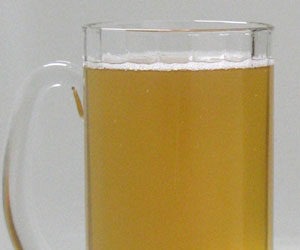Czech Pale Lager
Czech Pale Lager
(5 gallons/19 L, all-grain)
OG = 1.042 FG = 1.011
IBU = 29 SRM = 3.8 ABV = 4.1%
by Petr Bachan • Minneapolis, Minnesota
Ingredients
7.5 lbs. (3.4 kg) German Pilsner malt
7 oz. (0.2 kg) Caravienne malt (22 °L)
6 oz. (0.17 kg) German wheat malt
5 oz. (0.14 g) German acidulated malt (sauermalz)
3 AAU Magnum hops (first wort hop) (0.25 oz./7 g at 12% alpha acids)
2 AAU Czech Saaz hops (30 min.) (0.75 oz./21 g at 2.6% alpha acids)
2.6 AAU Czech Saaz hops (10 min.) (1 oz./28 g at 2.6% alpha acids)
3.6 AAU Magnum hops (10 min.) (0.3 oz./9 g at 12% alpha acids)
1 oz. (28 g) Czech Saaz hops (0 min.)
Wyeast 2633 (Oktoberfest Lager Blend) yeast
3⁄4 cup corn sugar (if priming)
Step by Step
This recipe uses reverse osmosis (RO) water. The water salt treatments are minimal; add 5 g calcium chloride (CaCl2) to the mash and 3 g CaCl2 to the sparge water. The acidulated malt is used to reach the desired mash pH; do not omit this ingredient unless you acidify your mash water. Do not add additional water salts to lower the pH; a minerally water character is inappropriate for this style.
Two or three days before brew day, make a 2-qt. (2-L) yeast starter, aerating the wort thoroughly (preferably with oxygen) before pitching the yeast. On brew day, mash in at 156 °F (69 °C) in 14 qts. (13 L) of water and hold this temperature until converted, 30 to 45 minutes. Pull a thick decoction of at least half the mash, then boil the decoction until it changes color and consistency, about 25 minutes. Stir the decoction frequently to avoid scorching. Return the decoction to the main mash and hold at 168 °F (76 °C) for mash out. Recirculate until clear, fly sparge with 168 °F (76 °C) water until 6.5 gallons (25 L) of wort is collected.
Boil the wort for 90 minutes, adding the hops at times indicated in the recipe. First wort hops are added to the kettle before the wort is run off. After adding the final hops when the heat is turned off, immediately begin chilling the wort. Chill to 43–45 °F (6–7 °C). Chilling to this low temperature may take two cooling stages or the use of an ice bath to reduce the temperature of the cooling water.
Oxygenate, then pitch the yeast starter. Allow fermentation temperature to rise to no more than 50 °F (10 °C) until desired final gravity (FG) is achieved. Then rack and slowly chill to lagering temperature. Lager for 4 to 6 weeks at 33 °F (1 °C). Prime and bottle condition, or keg and force carbonate to 2.4 volumes.
The original recipe used Best Malz for the base malt, a fully modified malt. If using an undermodified malt (such as Weyermann Floor-Malted Bohemian Pilsner malt), a true double decoction mash schedule can be used as described in the article. If using the Weyermann malt, you can also substitute the Weyermann Carabohemian® malt for the Caravienne. These products are malted specifically for making Czech-style beers.
Czech Pale Lager
(5 gallons/19 L, extract with grain)
OG = 1.042 FG = 1.011
IBU = 29 SRM = 3.8 ABV = 4.1%
Petr Bachan • Minneapolis, Minnesota
Ingredients
5.5 lbs. (2.5 kg) liquid Pilsner malt extract
4 oz. (0.11 kg) Caravienne malt
4 oz. (0.11 kg) German caramel wheat malt (45 °L)
3 AAU Magnum hops (60 min.) (0.25 oz./7 g at 12% alpha acids)
2 AAU Czech Saaz hops (30 min.) (0.75 oz./21 g at 2.6% alpha acids)
2.6 AAU Czech Saaz hops (10 min.) (1 oz./28 g at 2.6% alpha acids)
3.6 AAU Magnum hops (10 min.) (0.3 oz./9 g at 12% alpha acids)
1 oz. (28 g) Czech Saaz hops (0 min.)
Wyeast 2633 (Oktoberfest Lager Blend) yeast
3⁄4 cup corn sugar (if priming)
Step by Step
Use 6 gallons (23 L) of RO water in the brew kettle; heat to 158 °F (70 °C). Add 3 g calcium chloride to the water. Place the Caravienne and caramel wheat malt in a mesh bag, and steep in the hot water for 30 minutes. Remove the mesh bag, then turn the heat off.
Add the liquid malt extract and stir thoroughly to dissolve the extract completely. You do not want to feel liquid extract at the bottom of the kettle when stirring with your spoon. Turn the heat back on and bring to a boil. Boil the wort for 60 minutes, adding the hops at the times indicated in the recipe.
After adding the final hops when the heat is turned off, immediately begin chilling the wort. Chill to 43– 45 °F (6–7 °C). Chilling to this low temperature may take two cooling stages or the use of an ice bath to reduce the temperature of the cooling water. Oxygenate the wort, then pitch the yeast starter. Allow the fermentation temperature to rise to no more than 50 °F (10 °C) until the desired FG is achieved. Taste the beer for diacetyl; if noticeable diacetyl is present, raise the temperature to 65 °F (18 °C) for two days. Rack and slowly chill to lagering temperature. Lager for 4 to 6 weeks at 33 °F (1 °C). Prime and bottle condition, or keg and force carbonate to 2.4 volumes.
Written by Petr Bachan
A Czech Pale Lager is the lower alcohol little brother of the Czech Pilsner, and here is a recipe from a native of Czech Republic. The production methods are fairly unique, so if you’re looking for something different than your normal brew sessions, this recipe could be for you.



